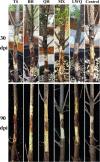Pathophysiology and transcriptomic analysis of Picea koraiensis inoculated by bark beetle-vectored fungus Ophiostoma bicolor
- PMID: 35928703
- PMCID: PMC9345248
- DOI: 10.3389/fpls.2022.944336
Pathophysiology and transcriptomic analysis of Picea koraiensis inoculated by bark beetle-vectored fungus Ophiostoma bicolor
Abstract
Ophiostomatoid fungi exhibit a complex relationship with bark beetles; exhausting of host tree defenses is traditionally regarded as one of the key benefits provided to beetle vectors. Ophiostoma bicolor is one of the dominant species of the mycobiota associated with Ips genus bark beetles which infect the spruce trees across the Eurasian continent. Host spruce trees resist fungal invasion through structural and inducible defenses, but the underlying mechanisms at the molecular level, particularly with respect to the interaction between bark beetle-associated fungi and host trees, remain unclear. The aim of this study was to observe the pathological physiology and molecular changes in Picea koraiensis seedlings after artificial inoculation with O. bicolor strains (TS, BH, QH, MX, and LWQ). This study showed that O. bicolor was a weakly virulent pathogen of spruce, and that the virulent of the five O. bicolor strains showed differentiation. All O. bicolor strains could induce monoterpenoid release. A positive correlation between fungal virulence and release of monoterpenoids was observed. Furthermore, the release rate of monoterpenoids peaked at 4 days post-inoculation (dpi) and then decreased from 4 to 90 dpi. Transcriptomic analysis at 4 dpi showed that many plant-pathogen interaction processes and mitogen-activated protein kinase (MAPK) metabolic processes were activated. The expression of monoterpenoid precursor synthesis genes and diterpenoid synthesis genes was upregulated, indicating that gene expression regulated the release rate of monoterpenoids at 4 dpi. The enriched pathways may reveal the immune response mechanism of spruce to ophiostomatoid fungi. The dominant O. bicolor possibly induces the host defense rather than defense depletion, which is likely the pattern conducted by the pioneers of beetle-associated mycobiota, such as Endoconidiophora spp.. Overall, these results facilitate a better understanding of the interaction mechanism between the dominant association of beetles and the host at the molecular level.
Keywords: Ips; monoterpenoids; ophiostomatoid fungi; spruce; transcriptome.
Copyright © 2022 Liu, Zhou, Wang, Wang, Zheng, Zhao and Lu.
Conflict of interest statement
The authors declare that the research was conducted in the absence of any commercial or financial relationships that could be construed as a potential conflict of interest.
Figures






Similar articles
-
Abundance and Diversity of Ophiostomatoid Fungi Associated With the Great Spruce Bark Beetle (Dendroctonus micans) in the Northeastern Qinghai-Tibet Plateau.Front Microbiol. 2021 Oct 18;12:721395. doi: 10.3389/fmicb.2021.721395. eCollection 2021. Front Microbiol. 2021. PMID: 34733243 Free PMC article.
-
Divergent Response of Two Bark Beetle-Fungal Symbiotic Systems to Host Monoterpenes Reflects Niche Partitioning Strategies.J Chem Ecol. 2024 Dec;50(12):994-1005. doi: 10.1007/s10886-024-01535-5. Epub 2024 Aug 21. J Chem Ecol. 2024. PMID: 39167252
-
Bark Beetle Attack History Does Not Influence the Induction of Terpene and Phenolic Defenses in Mature Norway Spruce (Picea abies) Trees by the Bark Beetle-Associated Fungus Endoconidiophora polonica.Front Plant Sci. 2022 May 6;13:892907. doi: 10.3389/fpls.2022.892907. eCollection 2022. Front Plant Sci. 2022. PMID: 35599904 Free PMC article.
-
Volatile Organic Compounds Emitted by Fungal Associates of Conifer Bark Beetles and their Potential in Bark Beetle Control.J Chem Ecol. 2016 Sep;42(9):952-969. doi: 10.1007/s10886-016-0768-x. Epub 2016 Sep 29. J Chem Ecol. 2016. PMID: 27687998 Free PMC article. Review.
-
Interactions among Norway spruce, the bark beetle Ips typographus and its fungal symbionts in times of drought.J Pest Sci (2004). 2021;94(3):591-614. doi: 10.1007/s10340-021-01341-y. Epub 2021 Feb 22. J Pest Sci (2004). 2021. PMID: 34720785 Free PMC article. Review.
Cited by
-
Integrated multi-omics investigation revealed the importance of phenylpropanoid metabolism in the defense response of Lilium regale Wilson to fusarium wilt.Hortic Res. 2024 May 20;11(7):uhae140. doi: 10.1093/hr/uhae140. eCollection 2024 Jul. Hortic Res. 2024. PMID: 38988612 Free PMC article.
-
Ophiostomatalean fungi associated with Polygraphus bark beetles in the Qinghai-Tibet Plateau, China.MycoKeys. 2024 Nov 1;110:93-115. doi: 10.3897/mycokeys.110.135538. eCollection 2024. MycoKeys. 2024. PMID: 39524405 Free PMC article.
References
-
- Arango-Velez A., Chakraborty S., Blascyk K., Phan M. T., Barsky J., El Kayal W. (2018). Anatomical and chemical responses of eastern white pine (Pinus strobus L.) to blue-stain (Ophiostoma minus) inoculation. Forests 9:690. 10.3390/f9110690 - DOI
-
- Bentz B. J., Six D. L. (2006). Ergosterol content of fungi associated with Dendroctonus ponderosae and Dendroctonus rufipennis (Coleoptera: Curculionidae, Scolytinae). Annu. Entomol. Soc. Am. 99 189–194.
LinkOut - more resources
Full Text Sources
Miscellaneous

